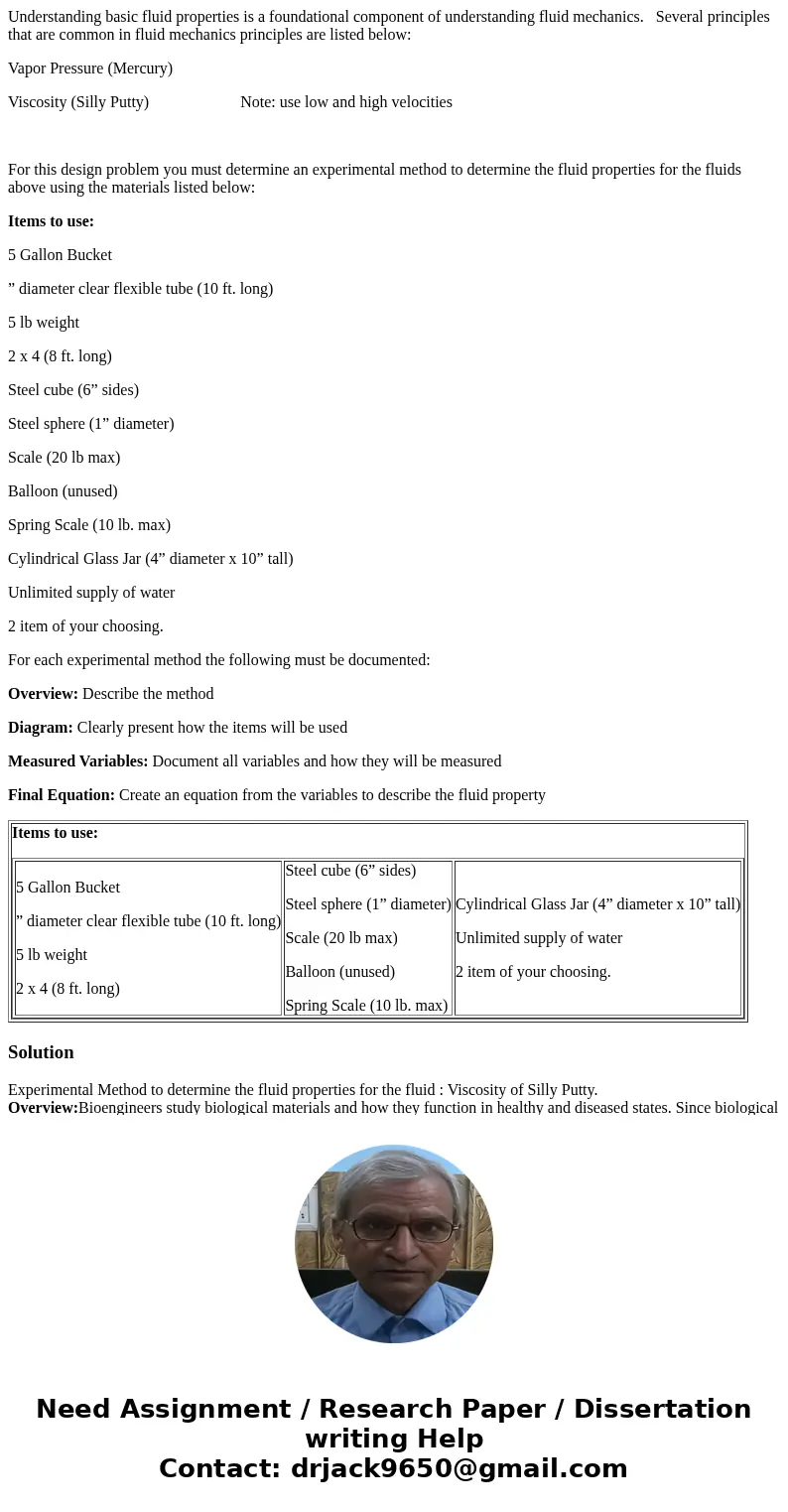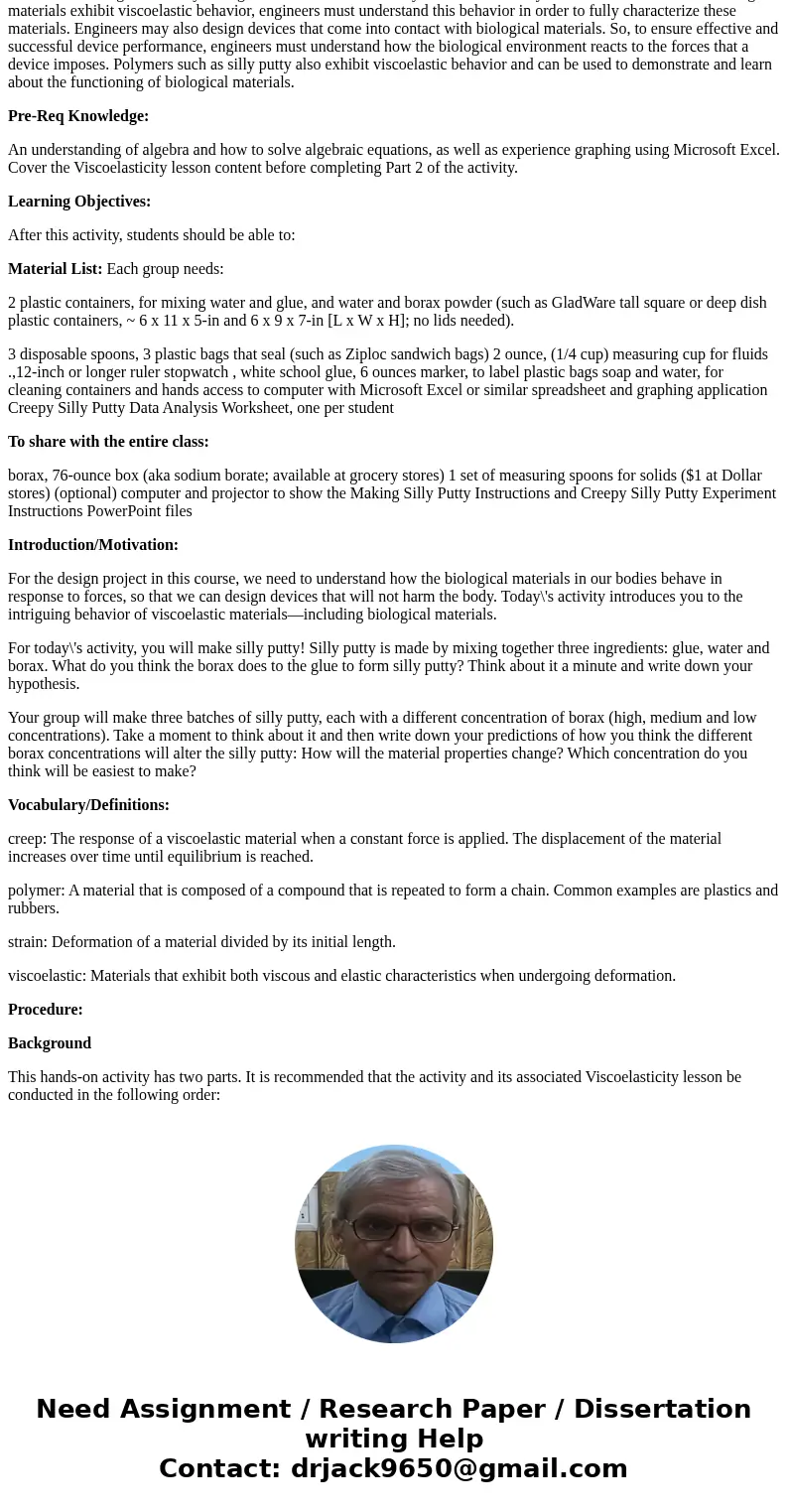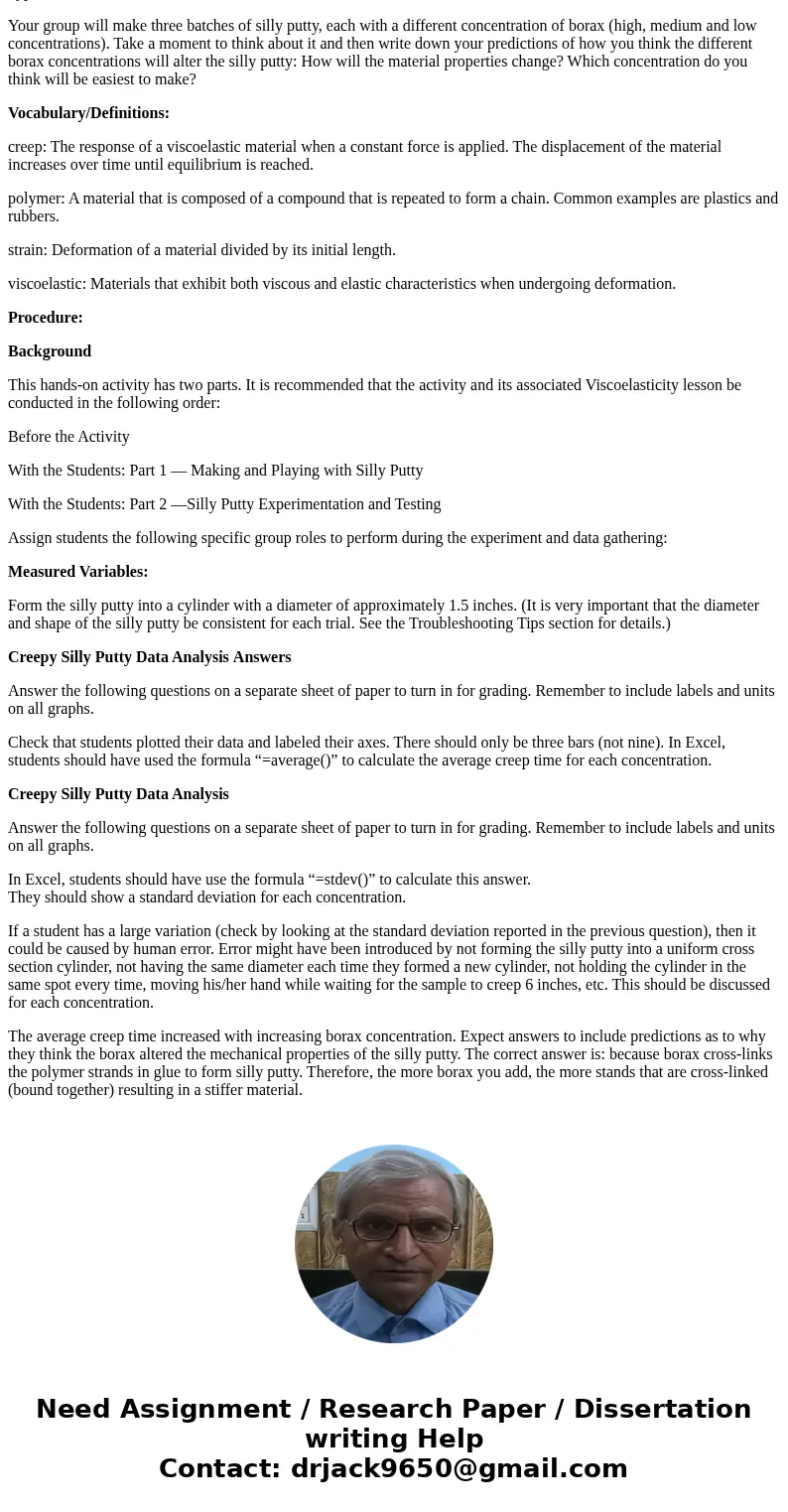Understanding basic fluid properties is a foundational compo
Understanding basic fluid properties is a foundational component of understanding fluid mechanics. Several principles that are common in fluid mechanics principles are listed below:
Vapor Pressure (Mercury)
Viscosity (Silly Putty) Note: use low and high velocities
For this design problem you must determine an experimental method to determine the fluid properties for the fluids above using the materials listed below:
Items to use:
5 Gallon Bucket
” diameter clear flexible tube (10 ft. long)
5 lb weight
2 x 4 (8 ft. long)
Steel cube (6” sides)
Steel sphere (1” diameter)
Scale (20 lb max)
Balloon (unused)
Spring Scale (10 lb. max)
Cylindrical Glass Jar (4” diameter x 10” tall)
Unlimited supply of water
2 item of your choosing.
For each experimental method the following must be documented:
Overview: Describe the method
Diagram: Clearly present how the items will be used
Measured Variables: Document all variables and how they will be measured
Final Equation: Create an equation from the variables to describe the fluid property
| Items to use:
|
Solution
Experimental Method to determine the fluid properties for the fluid : Viscosity of Silly Putty.
Overview:Bioengineers study biological materials and how they function in healthy and diseased states. Since biological materials exhibit viscoelastic behavior, engineers must understand this behavior in order to fully characterize these materials. Engineers may also design devices that come into contact with biological materials. So, to ensure effective and successful device performance, engineers must understand how the biological environment reacts to the forces that a device imposes. Polymers such as silly putty also exhibit viscoelastic behavior and can be used to demonstrate and learn about the functioning of biological materials.
Pre-Req Knowledge:
An understanding of algebra and how to solve algebraic equations, as well as experience graphing using Microsoft Excel. Cover the Viscoelasticity lesson content before completing Part 2 of the activity.
Learning Objectives:
After this activity, students should be able to:
Material List: Each group needs:
2 plastic containers, for mixing water and glue, and water and borax powder (such as GladWare tall square or deep dish plastic containers, ~ 6 x 11 x 5-in and 6 x 9 x 7-in [L x W x H]; no lids needed).
3 disposable spoons, 3 plastic bags that seal (such as Ziploc sandwich bags) 2 ounce, (1/4 cup) measuring cup for fluids .,12-inch or longer ruler stopwatch , white school glue, 6 ounces marker, to label plastic bags soap and water, for cleaning containers and hands access to computer with Microsoft Excel or similar spreadsheet and graphing application Creepy Silly Putty Data Analysis Worksheet, one per student
To share with the entire class:
borax, 76-ounce box (aka sodium borate; available at grocery stores) 1 set of measuring spoons for solids ($1 at Dollar stores) (optional) computer and projector to show the Making Silly Putty Instructions and Creepy Silly Putty Experiment Instructions PowerPoint files
Introduction/Motivation:
For the design project in this course, we need to understand how the biological materials in our bodies behave in response to forces, so that we can design devices that will not harm the body. Today\'s activity introduces you to the intriguing behavior of viscoelastic materials—including biological materials.
For today\'s activity, you will make silly putty! Silly putty is made by mixing together three ingredients: glue, water and borax. What do you think the borax does to the glue to form silly putty? Think about it a minute and write down your hypothesis.
Your group will make three batches of silly putty, each with a different concentration of borax (high, medium and low concentrations). Take a moment to think about it and then write down your predictions of how you think the different borax concentrations will alter the silly putty: How will the material properties change? Which concentration do you think will be easiest to make?
Vocabulary/Definitions:
creep: The response of a viscoelastic material when a constant force is applied. The displacement of the material increases over time until equilibrium is reached.
polymer: A material that is composed of a compound that is repeated to form a chain. Common examples are plastics and rubbers.
strain: Deformation of a material divided by its initial length.
viscoelastic: Materials that exhibit both viscous and elastic characteristics when undergoing deformation.
Procedure:
Background
This hands-on activity has two parts. It is recommended that the activity and its associated Viscoelasticity lesson be conducted in the following order:
Before the Activity
With the Students: Part 1 — Making and Playing with Silly Putty
With the Students: Part 2 —Silly Putty Experimentation and Testing
Assign students the following specific group roles to perform during the experiment and data gathering:
Measured Variables:
Form the silly putty into a cylinder with a diameter of approximately 1.5 inches. (It is very important that the diameter and shape of the silly putty be consistent for each trial. See the Troubleshooting Tips section for details.)
Creepy Silly Putty Data Analysis Answers
Answer the following questions on a separate sheet of paper to turn in for grading. Remember to include labels and units on all graphs.
Check that students plotted their data and labeled their axes. There should only be three bars (not nine). In Excel, students should have used the formula “=average()” to calculate the average creep time for each concentration.
Creepy Silly Putty Data Analysis
Answer the following questions on a separate sheet of paper to turn in for grading. Remember to include labels and units on all graphs.
In Excel, students should have use the formula “=stdev()” to calculate this answer.
They should show a standard deviation for each concentration.
If a student has a large variation (check by looking at the standard deviation reported in the previous question), then it could be caused by human error. Error might have been introduced by not forming the silly putty into a uniform cross section cylinder, not having the same diameter each time they formed a new cylinder, not holding the cylinder in the same spot every time, moving his/her hand while waiting for the sample to creep 6 inches, etc. This should be discussed for each concentration.
The average creep time increased with increasing borax concentration. Expect answers to include predictions as to why they think the borax altered the mechanical properties of the silly putty. The correct answer is: because borax cross-links the polymer strands in glue to form silly putty. Therefore, the more borax you add, the more stands that are cross-linked (bound together) resulting in a stiffer material.



 Homework Sourse
Homework Sourse